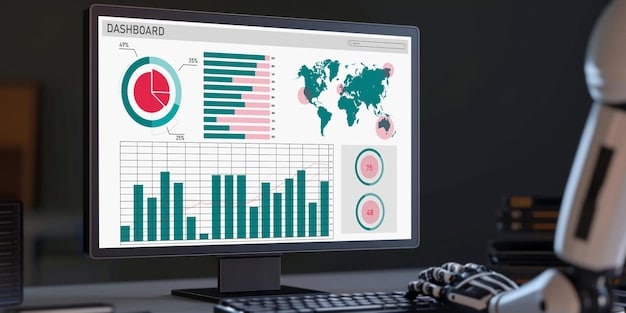Implement a Data-Driven Content Calendar: Boost Traffic by 25% in 6 Months

Implement a Data-Driven Content Calendar: Increase Organic Traffic by 25% in 6 Months by using data-driven insights to strategically plan and execute content, resulting in improved SEO performance and a significant boost in website traffic within a six-month timeframe.
Are you struggling to get your content seen? Want to **implement a data-driven content calendar: increase organic traffic by 25% in 6 months**? You’re not alone. Many marketers feel lost in the content chaos, unsure of what to create and when.
Imagine a clear content roadmap, guided by data, that steadily drives more visitors to your site. This article will show you how to **implement a data-driven content calendar: increase organic traffic by 25% in 6 months**, turning your content into a powerful growth engine.
Why Implement a Data-Driven Content Calendar?
A content calendar is more than just a schedule; it’s a strategic tool. Implement a data-driven content calendar: increase organic traffic by 25% in 6 months, you’ll move away from guesswork and towards informed decision-making. This shift can dramatically improve your content’s impact.
The Problem with Gut Feelings
Relying on intuition alone can lead to inconsistent results. While experience matters, data provides concrete evidence of what resonates with your audience. This allows you to optimize your content strategy for maximum effectiveness.
Benefits of a Data-Driven Approach
- Increased organic traffic through targeted content creation.
- Improved content engagement and readership.
- Better alignment with audience needs and interests.
- Enhanced ROI on your content marketing efforts.
By analyzing data, you can identify trends, understand which topics are most popular, and tailor your content accordingly. Implementing a data-driven approach allows you to be more strategic about your content creation, ultimately leading to better results.

In conclusion, implementing a data-driven content calendar transforms content marketing from a shot in the dark to a carefully aimed effort, maximizing impact and driving meaningful results for your business. Embrace data to truly see the potential of your content.
How to Gather Data for Your Content Calendar
Data is the fuel that powers a successful content calendar. To **implement a data-driven content calendar: increase organic traffic by 25% in 6 months**, you need to gather information from a variety of sources. Knowing where to look and what to look for is key.
Google Analytics
Google Analytics is a treasure trove of information. You can use it to track website traffic, identify top-performing pages, and understand user behavior. Pay attention to metrics like bounce rate, time on page, and conversion rates to gauge content effectiveness.
SEO Tools
Tools like Semrush, Ahrefs, and Moz can help you with keyword research, competitor analysis, and backlink tracking. Use these tools to identify high-potential keywords and understand what content is working well for your competitors.
Social Media Analytics
- Track engagement metrics like likes, shares, and comments.
- Identify trending topics and popular hashtags.
- Monitor audience demographics and interests.
Social media platforms provide valuable insights into what resonates with your audience. Understanding their preferences can help you create more engaging and shareable content.
Effectively gathering and interpreting data from these sources sets the stage for building a highly effective content calendar. It’s about listening to your audience and responding with content they truly value, driving up traffic and engagement over time.
Building Your Data-Driven Content Calendar
Once you’ve gathered your data, it’s time to build your content calendar. This is where theory meets practice. The aim is to **implement a data-driven content calendar: increase organic traffic by 25% in 6 months** through structured planning.
Choosing the Right Tools
There are many tools available to help you create and manage your content calendar. Options range from simple spreadsheets to sophisticated project management software. Choose a tool that fits your needs and budget.
Some popular options include:
- Google Calendar
- Trello
- Asana
- CoSchedule
Creating a Content Schedule
Based on your data, create a schedule that aligns with your audience’s preferences and online behavior. Consider factors like:
- Optimal posting times
- Frequency of content publication
- Distribution channels

Integrating SEO Best Practices
Incorporate SEO best practices into your content calendar to improve your search engine rankings. This includes:
- Targeting relevant keywords
- Optimizing meta descriptions
- Building internal and external links
Crafting this calendar should be a collaborative process within your team. This integration ensures that every piece of content is intentionally planned and optimized for success. By following these strategies, you transform a simple schedule into a powerful tool for organic growth.
Optimizing Content for Maximum Impact
A well-built content calendar is just the first step. To truly **implement a data-driven content calendar: increase organic traffic by 25% in 6 months**, you need to optimize your content for maximum impact. This involves refining your approach based on data and feedback.
Testing Different Content Formats
Experiment with various content formats to see what resonates best with your audience. Options include:
- Blog posts
- Infographics
- Videos
- Podcasts
Analyzing Performance Metrics
Continuously monitor your content’s performance using analytics tools. Pay attention to metrics like:
- Website traffic
- Engagement rates
- Conversion rates
Adapting Based on Feedback
Use the data you collect to refine your content strategy. This may involve:
- Adjusting your content topics
- Changing your posting schedule
- Experimenting with different calls to action
The commitment to continuous improvement is essential for the success of any content strategy. By being adaptable and data-driven, you are more likely to connect meaningfully with your audience and significantly enhance your online presence.
Measuring Success and ROI
The ultimate goal when you **implement a data-driven content calendar: increase organic traffic by 25% in 6 months** is to drive tangible results. But how do you know if your efforts are paying off? Measuring success and ROI are crucial to understanding the impact of your content strategy.
Defining Key Performance Indicators (KPIs)
Establish clear KPIs that align with your business goals. Examples include:
- Organic traffic growth
- Lead generation
- Sales conversions
Tracking Progress Over Time
Regularly monitor your KPIs to track your progress. Use data visualization tools to identify trends and patterns. Set benchmarks and regularly assess how you are performing against those benchmarks.
Calculating ROI
Determine the ROI of your content marketing efforts by comparing the costs of content creation and promotion to the revenue generated. This calculation will help you understand the financial impact of your strategy.
Measuring success doesn’t just validate your efforts; it provides critical insights that inform and refine your ongoing content strategies. This strategic approach ensures that every piece of content is contributing to the bottom line and supports your business growth.
| Key Point | Brief Description |
|---|---|
| 📊 Data Gathering | Collect data from Analytics, SEO tools, and social media. |
| 📅 Calendar Building | Create a content schedule using the right tools. |
| 📈 Optimization | Optimize content, analyse metrics, and adapt strategy. |
| 🎯 KPI tracking | Monitor KPIs and calculate content ROI regularly. |
Frequently Asked Questions
Google Analytics is a must-have. Supplement this with SEO tools like Semrush, Ahrefs, or Moz, and social media analytics from platforms like Facebook or Instagram to get a complete view with when you implement a data-driven content calendar: increase organic traffic by 25% in 6 months.
It’s best to review your content calendar monthly or quarterly. This allows you to incorporate new data, adjust to changing trends, and ensure that your strategy stays aligned with your business goals.
Absolutely! By focusing on data-driven insights and quality content, even small businesses can see significant improvements in organic traffic, potentially achieving the 25% increase within six months when they implement a data-driven content calendar: increase organic traffic by 25% in 6 months.
Start with what you have and focus on gathering more data over time. Refine your data collection methods to improve accuracy. Use industry benchmarks as a reference point until your own data becomes more robust. This will assist you as you implement a data-driven content calendar: increase organic traffic by 25% in 6 months.
Keyword research is a critical element in building a data-driven content calendar. It helps you identify the terms your audience is searching for, enabling you to create content that is relevant and optimized for search engines to implement a data-driven content calendar: increase organic traffic by 25% in 6 months
Conclusion
In conclusion, the key to unlocking a 25% increase in organic traffic within six months lies in strategically intertwining data with your content calendar. By mastering the art of data-driven analysis and content optimization, you set your brand up for robust, sustainable growth.
Armed with the strategies outlined, you’re now equipped to **implement a data-driven content calendar: increase organic traffic by 25% in 6 months**, paving the way for a thriving online presence and notable business success.





